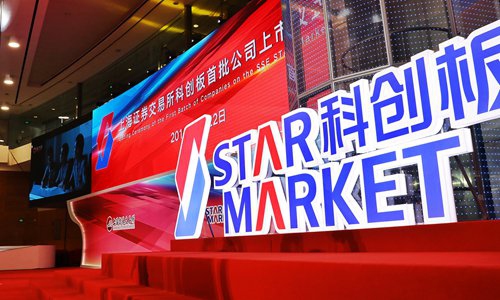China's STAR Market underpinning indigenous tech push amid US crackdown
By Li Qiaoyi Source: Global Times Published: 2020/8/1 18:03:08

The STAR Market in Shanghai, a tech and innovation-heavy board envisioned to fund the Chinese economy's shift to technology and financial sophistication, has been running for slightly over a year, underpinning the nation's push for indigenous prowess despite the multifaceted US crackdown on Chinese technologies.
Launched on July 22, 2019 with 25 firms, the new market has quickly risen to become one of the twin engines - along with the 10-year-old ChiNext market in Shenzhen - that are powering China's rise in the global technology arena.
Firms traded on the STAR Market mainly provide and produce information technology, new-energy vehicles, new materials, digital creations, biology, energy conservation, environmental protection and high-end equipment, said Wu Jinduo, head of fixed income at the research institute of Great Wall Securities, describing the two markets as bellwethers of China's new tech industries.
As of Friday, 397 firms were listed on the market, with 149 information and technology firms, 93 firms in the biology industry and 65 high-end equipment manufacturers.
Some of the businesses approved for a listing in the market are leaders in their respective industries, Wu told the Global Times on Saturday.
As of Friday, the market value of STAR Market stocks in circulation hit 1.53 trillion yuan ($219 billion), their price-to-earnings ratio over the trailing 12 months stood at 68.54 times and their price-to-book ratio for the most recent quarter was 12.49 times, according to Wu.
The accumulated funds raised by firms listed on the market topped 200 billion yuan as of July 17, with the firms' share prices surging an average 163 percent during their first days of trade, Zhang Bingwen and Lu Yiqiao at Zhixin Investment Research Institute wrote in a research note sent to the Global Times.
The toughening of US' securities regulations targeting China has prompted a homecoming by some US-traded Chinese firms, said Wu, noting that there's a strong likelihood some of the firms would float an offering on the STAR Market in response to the government's call for a "dual circulation" approach to economic development, seen as calling both domestic and global markets into play.
In a sign of the new market's vitality, the STAR 50, an index that was launched on July 23, closed up 2.73 percent to 1,512.98 points on Friday. The companies it tracks had gains of 51.3 percent for the year. The STAR 50 only slightly trails the ChiNext index, which has had a fabulous 55.46 percent year-to-date gain, overshadowing its US counterpart NASDAQ, which was up 19.76 percent so far this year by market close on Friday.
Wu said the STAR Market's activity levels and market capitalization could surpass the ChiNext, and as long as a well-functioning delisting mechanism is in place, both markets could be important contributors to the nation's push for a multilayered capital market.
The analyst also noted that the STAR Market's role in advancing the economy's restructuring won't likely come into full fruition for a few years.
It took many years for the likes of TSMC, Tesla and Apple to rise as tech giants, and firms on the STAR Market still have to focus on their core business, said Wu who wants the securities regulator to be tough on firms boarding the STAR Market to avoid turning the market into a conduit for making a quick buck.
Posted in: ECONOMY